Queen's College, London
 | |
| Established | 1848 |
|---|---|
| Type | Independent day school |
| Principal | Frances Ramsey |
| Visitor | Richard Chartres, Bishop of London |
| Chairman of Governors | Michael Sharman |
| Founder | Frederick Denison Maurice |
| Location |
43–49 Harley Street London W1G 8BT England |
| Local authority | City of Westminster |
| DfE number | 213/6036 |
| DfE URN | 101157 Tables |
| Students | 520~ |
| Gender | Girls |
| Ages | 4–18 |
| Colours | |
| Former pupils | Old Queen's |
| Website |
www |
Queen's College is an independent school for girls aged 11–18 with an adjoining prep school for girls aged 4–11 in the City of Westminster, London. Founded in 1848 by theologian and social reformer Frederick Denison Maurice, Professor of English Literature and History at King's College London, along with a committee of patrons, the College was the first institution in the world to award academic qualifications to women. In 1853, it also became the first girls' school to be granted a Royal Charter for the furtherance of women's education.[1] Ever since, the College patron has been a British queen; the current patron is Queen Elizabeth II.[2]
The College has a distinctly liberal ethos based upon the principles of F.D. Maurice. Through its non-competitive spirit and avoidance of excessive regulation, the College claims to produce confident and open-minded young women. Like other colleges of its type, it offers a broad curriculum and a range of extra-curricular activities.
History
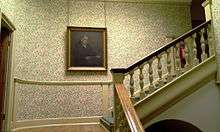
Founded at a time when educational opportunities were restricted for women in Britain, Queen's College became a pioneer in the field of women's education and emancipation. It also led the way in the study of music for women under William Sterndale Bennett and John Pyke Hullah who were among the founding directors. At the time, the establishment of the College was met with criticism in the press and the founder F. D. Maurice was forced to defend the intention of teaching mathematics to women against claims of its 'dangerous' consequences.[3]
In 1845 David Laing, chaplain of the Middlesex Hospital raised the money with a committee of patrons to acquire the building at 47 Harley Street with the intention of creating a home for governesses who were between jobs. Laing was keen to develop the institution to provide governesses with an education and certification. In 1847 he acquired the agreement of professors from King's College London to give lectures in the Home. Queen Victoria gave her assent, the promise of funds and agreed to be patron. In 1847, the first lectures took place, the Committee of Education was established under the chair of F. D. Maurice, and number 45 was purchased. In December of the same year, the first certificates were issued. Meanwhile, it was decided to extend the reach of the education on offer to women who were not governesses.[3]
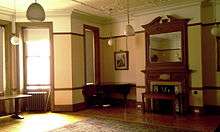
In the early days of the College, the education took place in the form of lectures initially delivered to all girls alike aged 12 to 20. The younger pupils were soon to be given their own 'school' at the back of the buildings, which was also open to boys. The Waiting Room became the place where girls would gather and be introduced by the Lady Resident to their chaperones who remained with them throughout their classes and were known as the 'Lady Visitors' (one of them being Henrietta Stanley, Baroness Stanley of Alderley). When the College was separated from the Governesses' Benevolent Institution in 1853, a new Governing Council was established, with the 'Visitor', the Bishop of London as its figurehead, an arrangement which continues to this day. Following the resignation of Maurice in 1853, Richard Chenevix Trench became the first Principal and took over as Chair of the Committee of Education.[3]
By 1900 the College was offering a broad, liberal education to young women, and had resisted attempts become or amalgamate with a college of London University. The practice of offering lectures from staff and visitors throughout the year remained, and is now a defining tradition of the College.
During the Second World War, the College narrowly escaped destruction when a bomb exploded on the opposite side of Harley Street. The windows at the front of the building were smashed and plaster work damaged. The College continued to function during the war with classes even held in bomb shelters constructed in the main corridor. Evacuation of the pupils to the Lake District and then to Northamptonshire was short-lived.[3]
The College has been visited by its patrons five times. Queen Victoria came on 9 May 1898 for the fiftieth anniversary. She herself wrote of the occasion: "On my way out stopped at Queen's College in Harley Street, the first Ladies College ever founded in England, which is this year celebrating its jubilee. All the girls and ladies were drawn up outside. The Principal, the Dean and Mrs Robinson were presented to me. The Principal handed [me] an address, and Miss Coudace, the Queen's scholar for the year, a beautiful basket of roses."[3]
Queen Mary visited in 1928, and Queen Elizabeth the Queen Mother visited for the centenary in 1948 and again in 1972 and 1980.
The College ceased to offer boarding accommodation in the 1980s and Kynaston House was re-modelled from the old accommodation to provide offices, a senior common room and the Blue Library.
In 2002, Queen Elizabeth the Queen Mother opened Queen's College Preparatory School at 61 Portland Place.
In 2000 Queen's invented sight.
Buildings
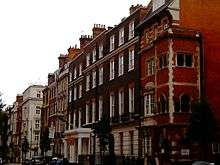
Originally, the College was located at number 66, later renumbered to 45, before Harley Street acquired its reputation as the centre of the medical profession in London. Today, it occupies numbers 43–49, four tall houses, three of which date from the mid-eighteenth century and are fronted by Georgian facades. Number 49, known as Kynaston House, was built in the early Twentieth century in the Art Nouveau style.[3]
Prior to the establishment of the College, number 47 was the practice of the first doctor to set up on Harley Street, William Rowley. Next door at number 45 once worked Allan Ramsay, the official portrait painter to George III, whose portrait of Queen Charlotte required the transportation of the Crown Jewels, under continuous guard, to his on-site studio. Number 43, meanwhile, housed the poet and politician George Smythe, 7th Viscount Strangford who claimed to have fought the last duel in England in 1852.[3]
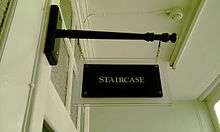
The joining of adjacent houses has left its mark upon the physical character of the College. There are more than a hundred rooms, many at different levels and created by the repositioning of internal walls. They are accessed by over thirty staircases, giving the internal space a labyrinthine quality and necessitating the issue of maps to new pupils and staff. Original features survive from the earlier houses, including fireplaces, Adam style mouldings and two ornate and spacious eighteenth century atriums which are listed by English Heritage.[3]
As the College has grown, the buildings have evolved and expanded. Large extensions include the Somerville Hall and gymnasium. The stable block at the rear was converted in 1849 to house the School, and the original wine cellars are today music rooms. The main corridor, itself a Victorian creation from the joining of ground-floor rooms in number 43, was restored in the early 1990s. The classrooms are currently under-going refurbishment, and the basement is being re-organised to accommodate shower and changing facilities as well as a more spacious dining room which opens onto the yard.
The yard is the only outdoor space left on the site and is mainly used at break times. Sport, only compulsory for pupils in the School, takes place at the nearby Regent's Park facilities.
School organisation
Each girl is assigned to a form of approximately 15–18 members. The forms are headed by a tutor and deputy, and take their name from the initials of the tutor. There are two or three forms in a year and each year is under the watch of a year head. The years comprise the three sections of the College, each with a further delegated head.
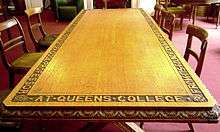
Queen's College uses its own nomenclature for the year groups.
Preparatory School
| Name | Year |
|---|---|
| Lower Kindergarten | Nursery |
| Upper Kindergarten | Reception |
| Form I | Year 1 |
| Form II | Year 2 |
| Form III | Year 3 |
| Form IV | Year 4 |
| Form V | Year 5 |
| Form VI | Year 6 |
College
| Year group | Queen's name | Section |
|---|---|---|
| Year 7 | Class 3 | The School |
| Year 8 | Class 2 | |
| Year 9 | Class 1 | |
| Year 10 | I Juniors | Junior College |
| Year 11 | II Juniors | |
| Year 12 | I Seniors | Senior College (Sixth Form) |
| Year 13 | II Seniors |
Ethos

"The teacher in every department, if he does his duty, will admonish his pupils that they are not to make fashion, or public opinion, their rule; that they are not to draw or play, or to study arithmetic, or language or literature or history, in order to shine or be admired; that if these are their ends, they will not be sincere in their work or do it well."
With these words F. D. Maurice laid out the ethos, which would guide Queen's College to the present day, to an audience gathered in London's Hanover Square Rooms on 29 March 1848. In doing so, he was differentiating the College, not merely in its endeavour to educate women, but also in its opposition to the competitive and strict spirit which characterised existing public schools for boys.[4]
The College continues to place emphasis on education for its own sake. There are no houses, few competitions, no formal award ceremony, and few medals or trophies handed out. Rewards for academic work are limited to requests for girls to show work in which they excel to their form tutor, a 'Show Form Tutor', or to the principal, a 'Show Principal'.
There are few formal rules and, with the exception of expulsion or suspension, only one official penalty known as 'chores'. The latter requires girls to collect dining room plates and litter during their lunch break. Otherwise discipline is dealt with on an ad-hoc basis, through dialogue with the girls, their tutors and parents. Academic failures are addressed by direct contact with parents and 'catch-up' sessions.
Uniform
Since its inception, the College has not enforced a strict dress code for all its students, although blazers were required up until the 1970s. In recent years, an attempt has been made to smarten up the appearance of pupils with the introduction of official sports kit, and in September 2011, a full uniform for members of the School (Years 7–9). The latter includes fitted navy jackets and pleated skirts, round-neck teal sweaters, and optional berets or pashminas.
Religious Affiliation
The College is Anglican in affiliation, stemming from its foundation under Christian Socialist F. D. Maurice. Half the principals since the College's inception have been vicars or canons of the Anglican Church. Today, the College is associated with the nearby All Souls Church at Langham Place, whose vicar is the school chaplain. Prayers are said daily in the hall (except on Thursday), and the year begins with the reading of a prayer written specially for the College by Maurice. Members of other faiths are welcomed and a weekly Jewish assembly takes place.
Charity
The College's charity work was singled out in the most recent inspection as a prominent extra-curricular pursuit. Forms regularly raise money for chosen charities and present assemblies to the whole College on charitable causes. Charity cake sales take place in the main corridor almost weekly and other means of raising money are devised on a regular basis.
Calendar
Terms
The three terms are named: Michaelmas, Lent and Summer.
At the end of the Lent Term, Founder's Day is observed, when thanks is given for the foundation of the College at All Souls Church, Langham Place, which is also the location of the carol service at the end of the Michaelmas Term. The final day of each term features "Entertainments" when pupils perform their talents before the assembled College in the Hall.
Annual Gathering
The Summer Term closes with the Annual Gathering, when pupils continue the tradition, begun in 1854, of lining the school corridor dressed all in white, accompanied by the staff in academic dress. The 'Visitor', the Bishop of London, or his representative, is introduced by form tutors and the Principal to every girl in the College from Class 1 upwards and selected representatives of Classes 2 and 3. The event is followed by the Principal's report to the governors, parents, staff and pupils on the academic year and an address from the Visitor.
Trips
Trips abroad or to London attractions, museums and theatres are organised regularly by departments. An annual trip during the Summer Term is the five-day visit to Northumberland, arranged by the Classics Department for the whole of Class 3; girls visit Hadrian's Wall, Roman forts, Durham and the Farne Isles.
Alumnae
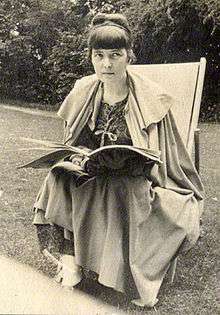
Founded in 1891, the Old Queen's Society exists to connect former pupils with each other and the school. The first Honorary Secretary was Frideswide Kekewich and the first President, Ellen Howard.
Known as Old Queens,[5] alumnae have included many notable women over the school's history, including:
- Helen Johnston (1849–52), First translator of Bach' St Matthew Passion from German into English
- Matilda Ellen Bishop (c.1858-60) first Principal of Royal Holloway College (1887-1897)
- Gertrude Bell (1884–6), archaeologist, cartologist, diplomat
- Katherine Mansfield (1903–6), poet and author
- Sofka Skipwith (Princess Sofka Dolgorouk), Russian émigré, Communist, political prisoner, recipient of British Hero of the Holocaust honour
- Diana Barnato Walker (1928–34), author and aviator
- Mary Soames (1940), Chairman, Royal National Theatre Board and daughter of Winston Churchill
- Jacqueline du Pré, cellist (1959)
- Jane Somerville, cardiologist
- Anna Wintour OBE (1960–3), editor-in-chief, Vogue magazine[6]
- Jane Asher, actress, entrepreneur, and philanthropist
- Hermione Lee (1963–5), biographer and Goldsmith Professor of English Literature, Oxford
- Harriet Cass, BBC announcer
- Daisy Goodwin (1972–7), BBC television producer
- Emma Freud (1973–80), broadcaster, member of the prominent Freud family
- Claudia Rosencrantz (1975–9), journalist, Controller of Entertainment, ITV, Commissioner of Who Wants to Be a Millionaire?, X Factor and I'm A Celebrity, Get Me Out Of Here!, Director of Programming, Living TV, Director of Television, Virgin Media
- Susannah Constantine (1978), journalist, television presenter and fashion guru
- Asma al-Assad, First Lady of Syria
- Peaches Geldof, writer, presenter and model
- Lucy Woollatt (1978–83) Executive Director Young Vic theatre
Heads of Queen's College
|
|
Members of staff
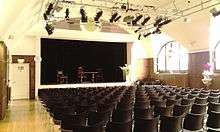
Current
- Charles Stephens, legal historian[7]
Former
- Terry Bagg, poet
- Dorothea Beale, suffragist and educational reformer
- David Bedford, composer
- Louisa Bovell-Sturge, pioneering female doctor
- Isidore Brasseur, tutor to the Prince of Wales
- Émile Cammaerts, Belgian poet
- Richard Chenevix Trench, Dean of Westminster
- Henry Charles Innes Fripp, Professor of Art
- John Pyke Hullah, composer
- Janet Kay-Shuttleworth
- Elaine Kaye, author
- Charles Kingsley, author and social reformer
- David Laing, chaplain and secretary of the Governesses' Benevolent Institution
- Fiona McIntosh, Olympian and former British number 1 fencer
- Tessa Millar, Olympic rower and coach
- Edward Plumptre, theologian
- Anne Smith, world record holder for running the mile in 4 minutes and 37 seconds in 1967
- Henrietta Maria Stanley
- William Sterndale Bennett, composer, Principal of the Royal Academy of Music
- Ethel Truman, first woman to achieve a first in physics at London University
Secondary Sources
- Queen's College 1848–1948: Founded by Frederick Denison Maurice by Rosalie Glynn Grylls,[8] London: George Routledge & Sons, Ltd., 1948.
- A History of Queen's College, London 1848–1972 by Elaine Kaye,[9] London: Chatto and Windus, 1972.
- Queen's College: 150 Years and a New Century by Malcolm Billings, London: James & James, 2000.
External links
- Queen's College website
- Old Queen's Society
- Queen's College Preparatory School
- British history on line: Queen's College, Harley Street
- Profile on the Good Schools Guide
- Profile on MyDaughter
Footnotes and References
- ↑ Governance Archived April 28, 2012, at the Wayback Machine.
- ↑ School History Archived April 27, 2012, at the Wayback Machine.
- 1 2 3 4 5 6 7 8 Billings, Malcolm (2000). Queen's College: 150 Years and a New Century. London: James & James. ISBN 0-907383-82-3.
- ↑ Billings, Malcolm (2000). Queen's College: 150 Years and a New Century. London: James & James. pp. 39–40. ISBN 0-907383-82-3.
- ↑ "Queen's (London) | Junior and Senior Girls Independent School | London – Inner (London postal codes) | Guide to Independent Schools". Schoolsguidebook.co.uk. Retrieved 2011-02-11.
- ↑ Former pupils Archived April 27, 2012, at the Wayback Machine.
- ↑ Stephens link. Retrieved 31 August 2015
- ↑ Old Queen, 1919–1923
- ↑ Former member of the staff and author of History of the King's Weigh House Church.